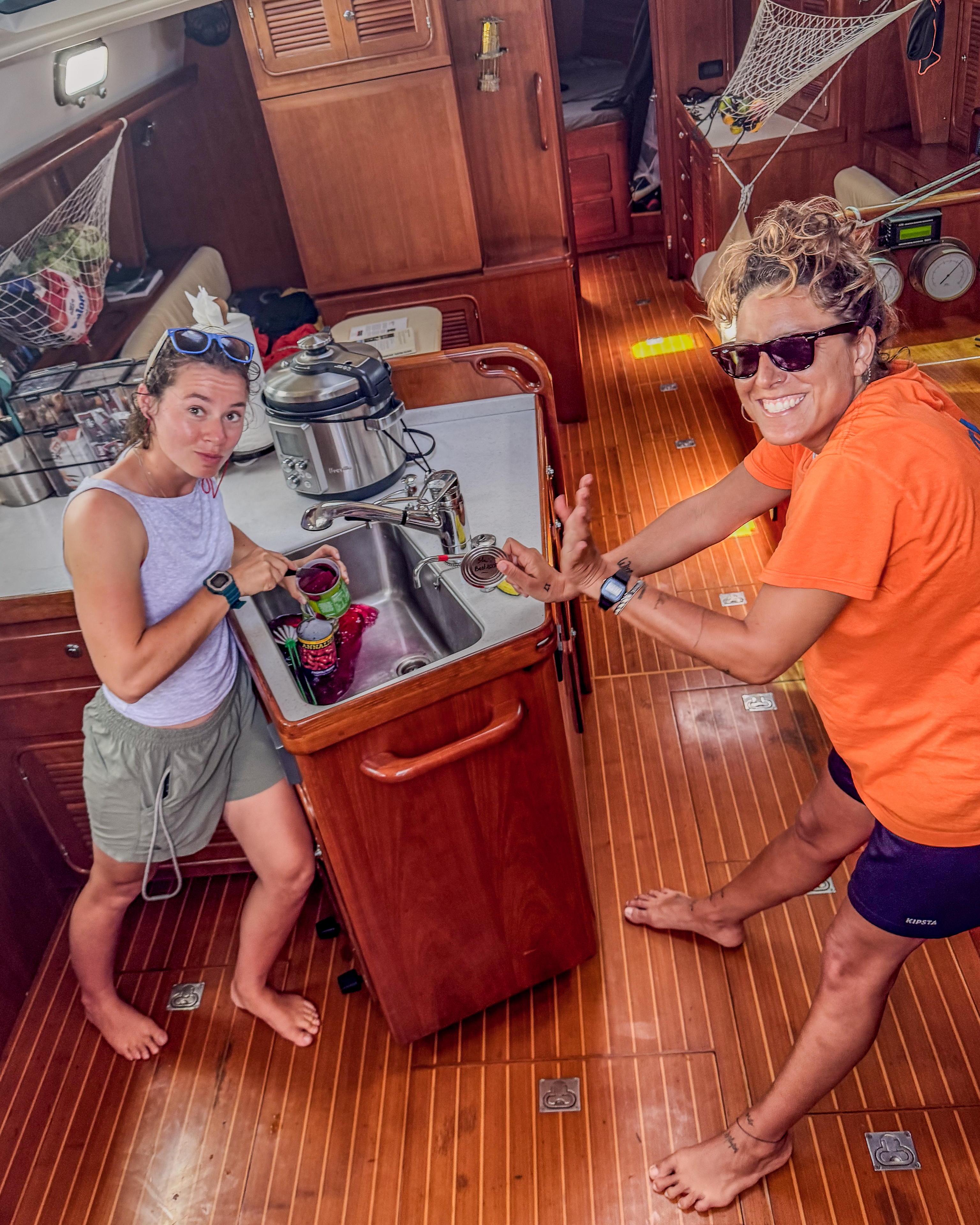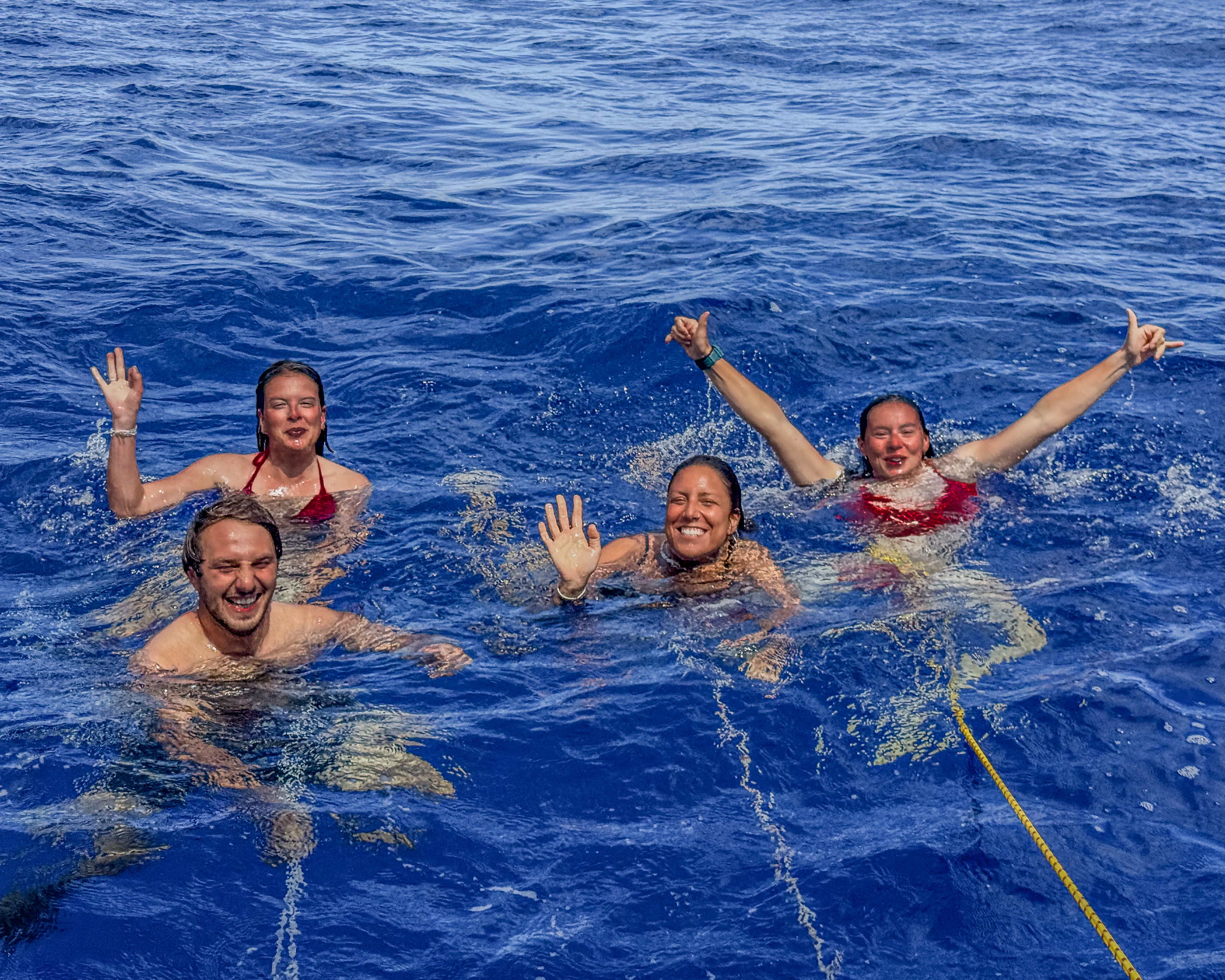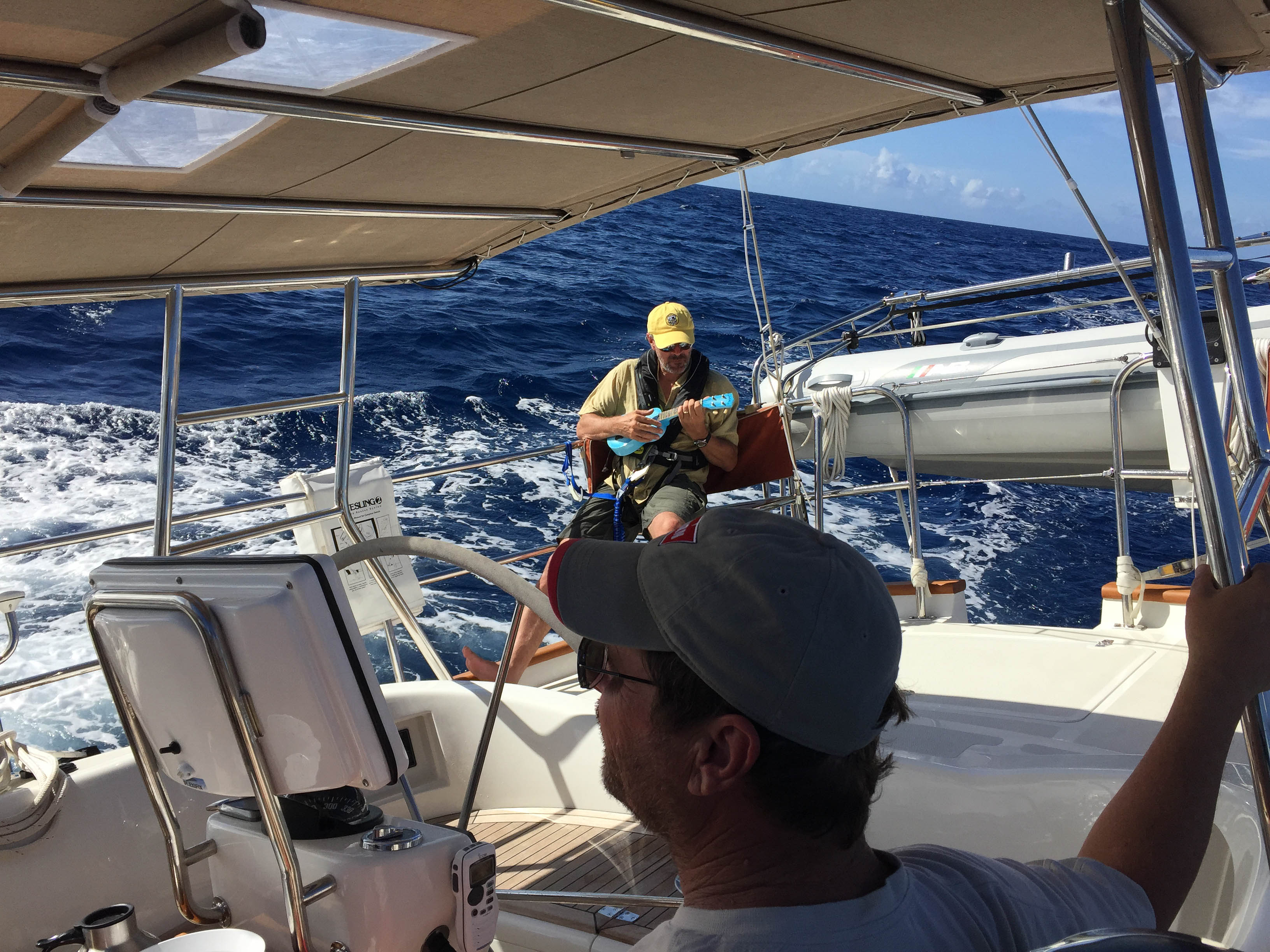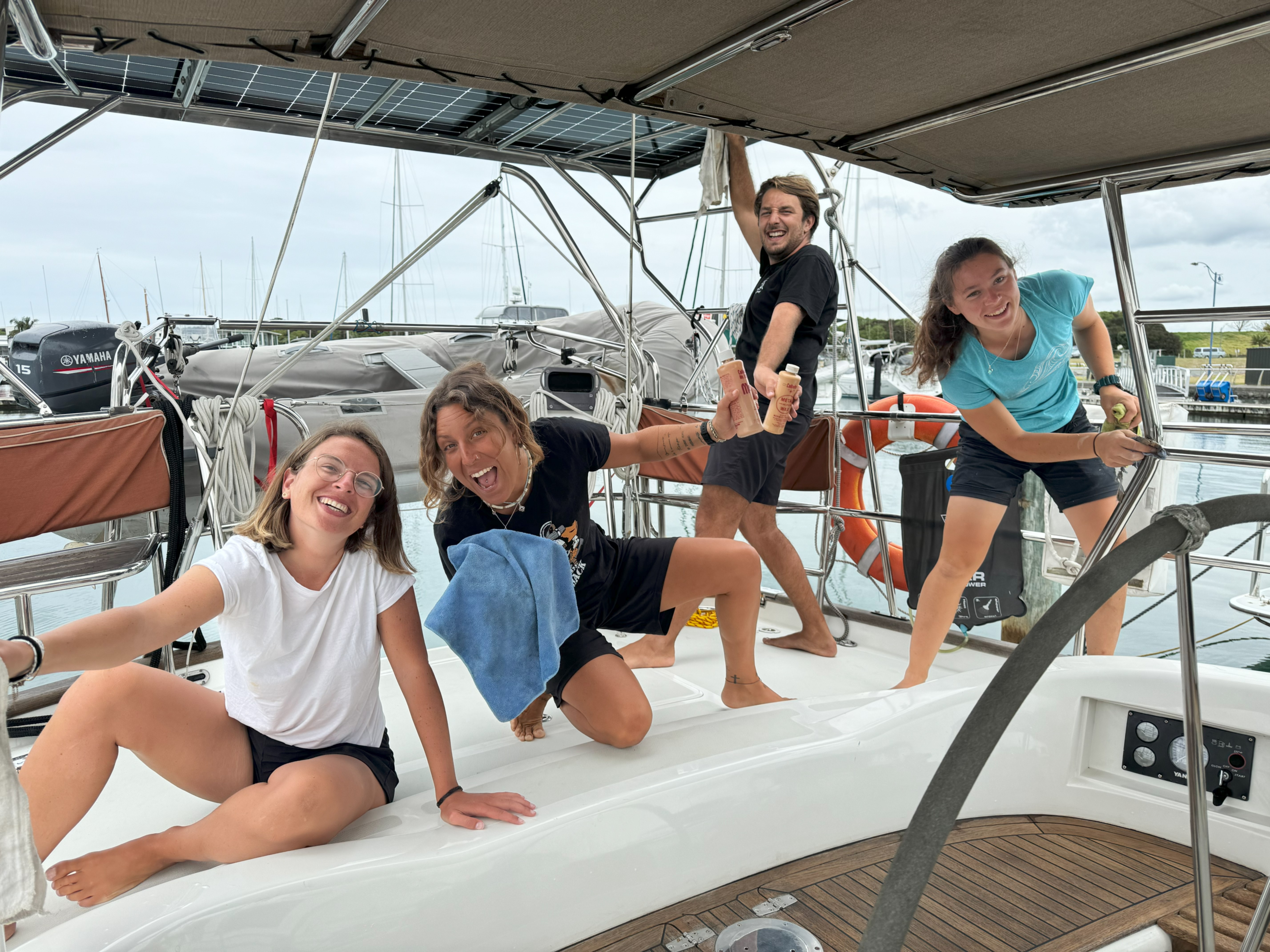I’ve been voyaging under sail for nearly two decades now and, since 2014, on Wanderlust, our semi-custom Passport 545 Aft Cockpit. Wanderlust was designed and outfitted for short-handed sailing and passagemaking, and she delivers on that promise. I’ve solo-sailed her across the Pacific — from La Paz, Mexico all the way to the Marquesas — and Jane and I regularly sail her double-handed. In short: we don’t need additional crew to sail this boat safely or comfortably.
But every so often, we choose to open Wanderlust to others. Not to fill bunks. Not to lighten the watch schedule. Simply to share the experience. Voyaging offers something unique — a stripped-down rhythm of life at sea that is equal parts challenge and reward — and it can be deeply meaningful to invite the right person into that rhythm.
Jane joined me a little over a year ago, and together we’ve voyaged through much of French Polynesia. Along the way, we’ve welcomed crew for a single long passage: from New Zealand to the Tuamotus. That experience underscored what we already knew — the right crew can enrich the boat’s life, while the wrong fit can make even a fair-weather passage feel longer than it is.
So when we consider taking on crew, we’re intentional. We know what makes our life aboard work, and what doesn’t. This article is our attempt to lay that out: not as a list of hard rules, but as a way to help the right kind of sailor — or sailor-to-be — know if they’d be a good fit aboard Wanderlust.
Passages and Landfalls
One of the gifts of voyaging is that life at sea becomes its own world. Days aren’t measured by miles but by experiences — watches, flying fish, sunsets, and stars. The horizon stretches in every direction, the boat becomes your entire universe, and time slows into a rhythm that feels both ancient and new. That’s the magic we look forward to sharing with the right crew.
But if your picture of sailing comes from YouTube highlight reels or glossy Instagram posts, it’s incomplete. Yes, there are sunlit anchorages, dolphins at the bow, and those postcard-perfect landfalls. But between those moments are long passages — days or weeks when the boat never stops moving, meals are cooked with one hand braced, and the night watch is your responsibility, not background footage set to music.
That’s not a complaint; it’s the essence of voyaging. A passage is an immersion, not a photo op. You start to notice the subtle rhythm of swells, the way the sky shifts shades of blue, the first flying fish skittering across the deck at dawn. You measure life in stars and sunrises, meaningful conversations, and quiet hours at the helm. When land finally appears, it isn’t just “arrival.” It’s the punctuation mark on a chapter you’ve lived fully.
And yes, sometimes it really is like the videos. Dropping anchor in a lagoon where the water glows turquoise, swimming ashore to a palm-fringed beach, sharing a meal in the cockpit while the sun sets behind a volcanic peak — those are the rewards that make the hard miles worthwhile. The dream is real, but it’s only half the story. The other half happens on the way there.
We’ve seen both kinds of crew. Some arrive expecting only the lifestyle they’ve seen online and quickly count down the days until landfall. Others embrace the rhythm of the passage itself — and then savor the destination even more when it finally rises over the horizon.
A Bluewater Home, Not a Condo
Step aboard Wanderlust and you’ll find a boat that’s comfortable, but not in the way a glossy brochure might define the word. Comfort here means good ventilation on a hot afternoon, a secure galley where meals can be prepared even in a rolling sea, and a solid sea berth where you can sleep soundly off watch. It’s the comfort of a boat designed for bluewater passagemaking, built to be seakindly when the seas are up, and equipped with systems that work offshore. Comfort, in other words, rooted in capability.
That’s the kind of comfort that lets us anchor for weeks in remote atolls with no other boats in sight, watching reef sharks patrol the shallows and the Milky Way spill across the night sky. For us, luxury isn’t granite countertops or long, hot showers — it’s the ability to live independently, on our terms, in places most people will never see. (Curious about Wanderlust’s design and construction? See the full spec and build notes on our About Wanderlust page.)
Of course, that doesn’t mean Wanderlust is a floating condo. We’ve chosen not to fill her with fragile conveniences or energy-hungry systems, because every extra complication chips away at our freedom to roam. Boats that chase shore-style amenities often pay for them in fuel, running generators daily just to keep the air conditioning humming. We’d rather let the sun charge our batteries, trim our systems to sip power, and save diesel for when it’s truly needed.
Water and power are managed carefully, and space is shared deliberately. That simplicity isn’t deprivation. It’s what makes voyaging possible.
Crew who come aboard need to understand that distinction. If your idea of “comfortable” is air conditioning and endless outlets, you may find our lifestyle spartan. But if comfort to you means competence, resilience, and the freedom to explore far from the beaten path, you’ll feel right at home.
Experience Helps, Attitude Matters More
You don’t need to be a seasoned sailor with decades at sea to be a good fit aboard Wanderlust. Some of the best passages we’ve shared have been with people who were new to offshore life. What matters more than miles logged is the right attitude — open, curious, and willing to step into the rhythm of the sea. A sense of wonder at the sunrise after a night watch. An appreciation for the sea in all its moods — calm, rough, and everything in between. A willingness to adapt when the weather shifts or the plan changes. If you can bring those qualities, we can teach you the rest.

A bit of coastal experience helps, of course. A weekend sail or two gives you a taste of motion that never stops, the feel of a small space that must be shared, and the truth that a galley is more about balance than countertops. That experience doesn’t make you a sailor, but it does help you understand whether life afloat resonates with you.
And while wonder is essential, so is respect. Offshore sailing is safe when everyone treats it that way, but it’s not without risk. The sea rewards attention and humility; it punishes carelessness. Good crew carry that reality lightly — not with fear, but with a steady respect that keeps the magic possible.
Equally important is the ability to laugh when things aren’t going smoothly — when the meal slides across the galley, when the squall soaks you on watch, when the plan changes for the third time in a day. Humor doesn’t make those moments disappear, but it makes them lighter, easier to carry, and a lot more memorable for the right reasons.
More Than Skills: What We Value in People
We look for people who are curious, adaptable, interesting. People who can tell a story under the stars, who bring something of themselves beyond “I can trim a mainsail.”
Skills are useful, but they’re not the primary currency on Wanderlust. What matters most is who you are in the compressed world of a voyaging boat, where space is shared and days unfold side by side.
We value people who bring curiosity — about the sea, about the places we travel, about life in general. The kind of people who see voyaging as more than miles, and who notice the details: the way the sky changes through a night watch, or the taste of bread baked underway.
We value good company. Not constant chatter, but presence. Someone who can swap stories over coffee, share music at sunset, or sit comfortably in silence without needing to fill the gaps. Some of the best crew we’ve sailed with were quiet by nature, but thoughtful and engaged — people who added depth to the passage simply by being themselves.
And it’s always a bonus when crew bring something tangible to the boat — an instrument, a knack in the galley, or mechanical hands when a pump goes sulky. These contributions, big or small, matter more than how quickly anyone can trim a sail. They add texture to the days and make the voyage richer for everyone aboard.
Because skills can be taught. But curiosity, good humor, and the willingness to share something of yourself — those you either bring aboard or you don’t. And they’re what make the difference between someone who just fills a bunk and someone who shapes the memory of a voyage.
Mentorship: Sharing the Whole Picture
One of the things I enjoy most about taking on crew is the chance to teach. Not in a classroom sense, but in the way voyaging naturally teaches anyone who’s paying attention. A passage is the best instructor you’ll ever find — immersive, relentless, and honest.
We don’t expect crew to arrive knowing much. What matters is that they want to learn. And what we teach goes well beyond pulling on sheets. It’s how to stand a proper watch at night. How to read the sky and the sea, not just the forecast. How to navigate confidently, and how to make the small, steady decisions that keep a boat safe offshore. That’s seamanship — the craft every sailor builds over time.
Beyond seamanship sits the cruiser’s toolkit: cooking in a galley that won’t stop moving, stowing gear so nothing becomes a projectile, and improvising when something breaks miles from the nearest chandlery. Not seamanship proper, but essential to the sea-gypsy life.
For the right person, all of this is more opportunity than burden. We’ve watched crew step aboard as novices and step ashore with a new confidence, surprised by just how much they learned along the way. The ones who lean in — who ask questions, who take their turn in the rhythm of the boat — they gain something lasting. The ones who don’t? They usually leave with nothing more than a suntan and some photos.
Because voyaging isn’t about being carried along. It’s about joining in. And for those who want to learn, there’s no better classroom than a boat moving steadily across an open sea.
Getting There and Being There
A lot of people think of sailing only in terms of arrival. The beach, the lagoon, the sundowner in the cockpit. And don’t get me wrong — those are wonderful moments. Dropping anchor in a turquoise lagoon or stepping ashore on an island few have heard of can feel exactly like the YouTube dream. That’s part of why we voyage.
But passages aren’t just the price you pay to get there. They’re half the experience, and for us, often the most memorable half. There’s a rhythm that settles in when you’re days offshore: the cycle of watches, the slow arc of the sun, the smell of bread baking in a gimbaled oven, the Milky Way spilling across the sky during a night watch. It’s a life pared down to essentials, and in that simplicity you find a richness that’s hard to describe until you’ve lived it.

Some crew thrive in that rhythm. They find joy in the stillness of the sea at dawn, in the camaraderie of a night watch, in the steady satisfaction of seeing miles tick away on a course line. Others endure it — waiting for the anchor to drop so the “real” adventure can begin.
We look for the first kind. The ones who don’t just want to get somewhere, but who are alive to the experience of being out there. Because in voyaging, the two are inseparable: the getting there and the being there are different verses of the same song.
If you can delight in both — in the landfall and the long days that carried you to it — then you’ll understand why so many sea gypsies, ourselves included, sometimes feel a little bittersweet when the passage ends.
The Practical Side: Life Aboard Wanderlust
A few ground rules help keep life aboard Wanderlust safe, comfortable, and fair for everyone.
First, the non-negotiables: Wanderlust is a strict no-smoking boat. There are no recreational or non-prescription drugs allowed on board. And while we enjoy a glass of wine or a sundowner once the anchor is down, there’s no alcohol underway. Offshore sailing demands a clear head, day and night.
Jane and I cover all of Wanderlust’s core expenses, including provisioning, fuel, and the never-ending list of maintenance items that keep a bluewater passagemaker moving. Crew are responsible for their own travel to and from the boat, and for any shore excursions or personal expenses once we’re in port.
Food is central to life aboard, but it comes with limitations. We’ve learned from experience that accommodating special diets — vegan, vegetarian, or otherwise — is too difficult on a boat that provisions in remote islands and often relies on what’s available. Provisioning separately, sourcing hard-to-find ingredients, or cooking multiple meals simply isn’t practical at sea. That doesn’t mean the food is bad — far from it. We both enjoy good meals, and I once owned a French restaurant — but voyaging means adapting. Sometimes dinner is fresh fish and island produce, and other times it’s canned stews, beans, or soups we’ve pressure-canned ahead of time. We bake bread, make yogurt from powdered milk, and make the most of what we can store. The food is hearty, nourishing, and part of the rhythm of the sea-gypsy life.
Finally, we expect everyone aboard to pitch in with the daily work that keeps the boat ship-shape. “A place for everything and everything in its place” isn’t just a saying at sea — it’s a safety practice. Crew take part in cooking and cleaning, polishing stainless, tending the brightwork, washing down decks, and the myriad other small tasks that make a boat run smoothly. None of it is glamorous, but all of it matters.
The Contribution Debate
Few topics stir more debate in the cruising community than crew contributions. Some skippers treat volunteer crew almost like paying guests, arguing that the “experience” of voyaging on a capable boat is worth thousands — comparable to chartering or even a small-ship cruise. Crew are asked to pay daily rates, often far above their share of food or fuel.
To me, that’s a false comparison. Wanderlust isn’t a charter yacht, and we aren’t in the business of selling holidays. Crew aren’t here as passengers; they’re here to live the life we live — sharing in the work, the rhythm, and the rewards of passagemaking.
Our philosophy is simple: we cover the expenses of the boat, including provisioning, fuel, and maintenance. Crew trade sweat equity for the experience. They stand watches, cook meals, clean, and take part in the ongoing care of the boat. That balance feels fair. You contribute your effort, and in return you receive food, lodging, and the rare experience of voyaging offshore on a capable bluewater boat.
There’s also a legal dimension. Laws vary by flag and jurisdiction, but most draw a bright line between private vessels and licensed charters. A fair share of bona fide trip costs is one thing; fixed “berth fees” or commercial day rates are another. Charging anything that resembles a commercial rate — a berth fee or fixed daily price — drifts into murky water, if not outright illegality. That’s not a line we’re interested in approaching.
On Wanderlust, clarity is everything. Nobody mistakes us for a charter operation, and nobody feels they’ve “paid” for the right to be a passenger. This is about sharing the sea-gypsy life — not turning our home into a business.
Lessons Learned From Past Crew
Experience has taught me that who you bring aboard shapes the voyage as much as the weather. Some crew make the boat lighter, others make it heavier — and it doesn’t always match the logbook on their résumé.
Once, a couple joined me for a long passage through the South Pacific to New Zealand. He claimed offshore experience and promised the no-smoking rule wouldn’t be a problem. The first night out, he asked where he could light up. He sulked when reminded of the rule, struggled with life on a heeled monohull, and never really settled in. His real motivation, it turned out, wasn’t sailing at all — he wanted a free ride to New Zealand, where a camper van was already waiting for him.
His partner was the opposite. She had no sailing background, but she fell in love with the rhythm of passage life. I’d come on deck to relieve her on watch and find her grinning ear to ear, marveling at the stars. She learned sail trim quickly, pitched in cheerfully, and became a real asset. By the time we reached New Zealand, they weren’t speaking, and I asked him to leave. She stayed for several weeks more and is still a friend — and plans to rejoin Wanderlust.

Another passage brought us a young New Zealander with a little coastal experience and a lot of enthusiasm. She was only 22, but from day one she wanted to learn, to understand, to take part in everything. She absorbed every lesson, stood her watches with confidence, and delighted in the adventure. She stayed aboard for two months after landfall, cruising with us through Moorea and the Tuamotus. Her energy and curiosity made her a joy to have aboard.
Not every story is about youth or inexperience. A man in his fifties once joined me for the passage from the U.S. to the Caribbean. He’d done some lake sailing and plenty of coastal powerboating, but wanted to see what a true bluewater passage was like. He thrived offshore. Intelligent, thoughtful, and quick to adapt, he was the kind of crew who made the miles fly by. I remember a night watch where we debated Einstein’s theory of relativity — could we determine if Wanderlust was moving through the ocean, or if the ocean was moving beneath us? When he wasn’t pondering physics, he was strumming a ukulele in the cockpit. He enjoyed the passage so much that he went on to buy his own sailboat, sailed the Mediterranean, and eventually crossed the Atlantic back to the Caribbean.
And then there were two older sailors, both competent at the helm, who joined for a taste of passagemaking on a Passport 545. Their sailing was fine. Their living, less so. Their cabin was chaos, their cooking stopped at sandwiches, and when we made landfall, their focus was on the nearest bar. They sailed the miles, but they never really joined the life.
Different people, different outcomes. But they all underline the same truth: seamanship can be taught. Fit cannot. The right crew doesn’t just move the boat — they add to its spirit. The wrong crew, no matter how skilled, makes every mile longer.
Why the Right Crew Matters
When Jane and I invite crew aboard Wanderlust, it isn’t because we need the help. She’s set up for short-handed sailing, and we’re perfectly capable of making passages on our own. We do it because voyaging is richer when shared with the right people.
The right crew brings more than skills. They bring curiosity, respect for the sea, good humor when things go wrong, and a willingness to contribute to the small daily work of keeping a voyaging boat moving. They see both halves of the story — the getting there and the being there — and find joy in each.
The wrong fit, on the other hand, turns even fair winds into a slog. And that’s why we’re intentional about who we invite aboard. This isn’t a charter, a shortcut, or a vacation. It’s an immersion into the sea-gypsy life — a life of freedom, simplicity, and self-sufficiency, measured not in miles but in moments.
For those who understand that, the reward is far greater than a passage from one port to another. It’s learning what it feels like to live at sea, to be self-reliant, to wake each morning with nothing on the horizon but possibility. Those are the crew who step ashore with more than memories — they leave with a piece of the voyaging life stitched into who they are.
In the end, boats sail on wind and water — but good voyages sail on good people.
